
LINK: https://www.asiancinevision.org/cinema-spotlight-your-day-is-my-night/
by Yiping Qin (Lesley)
In How the Other Half Lives (1890), the seminal book of photojournalism, Jacob Riis documented in his pictures the living condition inside the cramped “shift-bed” houses at the Lower East Side, where immigrants shared beds to minimize lodging expenses. “The metropolis is to lots of people like a lighted candle to the moth,” wrote Riis, “It attracts them in swarms that come year after year with the vague idea that they can get along here if anywhere.”
With her continuous interest in personal historiography and mixed media, renowned experimental documentary filmmaker Lynne Sachs probes into this kind of urban existence beyond visual sensation. What are the stories of these unrooted people? How do they bond in this living environment? Staged in central Chinatown, YOUR DAY IS MY NIGHT is a hybrid documentary that recreates the shift-bed experience. With autobiographical monologues, observational footage, and performance pieces, it tells a series of stories from different generations of Chinese immigrants, about the historical violence afflicting their homeland, the hardship of surviving in the new world, the anxiety about being undocumented, the becoming of a de facto family in the second hometown and the muffled desire to break out.
Lynne Sachs (director & producer), Sean Hanley (co-producer & co-cinematographer), Jenifer Lee (translator) and the Chinese performers – Yi Chun Cao, Linda Y.H. Chan, Chung Qing Che, Ellen Ho, Yun Xiu Huang, Sheut Hing Lee and Kam Yin Tsui – sat with CineVue for an interview at Lin Sing Association, the hub for the Chinese community in lower Manhattan Chinatown. Here is the interview in English with Lynne and Sean, where they talked about the creative process, fiction and facts, documenting and performance, and the lovely collaboration that started two years ago, when she simply asked “Do you have any story about beds?”
YOUR DAY IS MY NIGHT held three performances at the University Settlement in December, 2012. The documentary will world premiere at The Museum of Modern Art on Sunday, Feb 24 at 2:00pm and Monday, Feb 25 at 8:00pm. Check out screening details here.
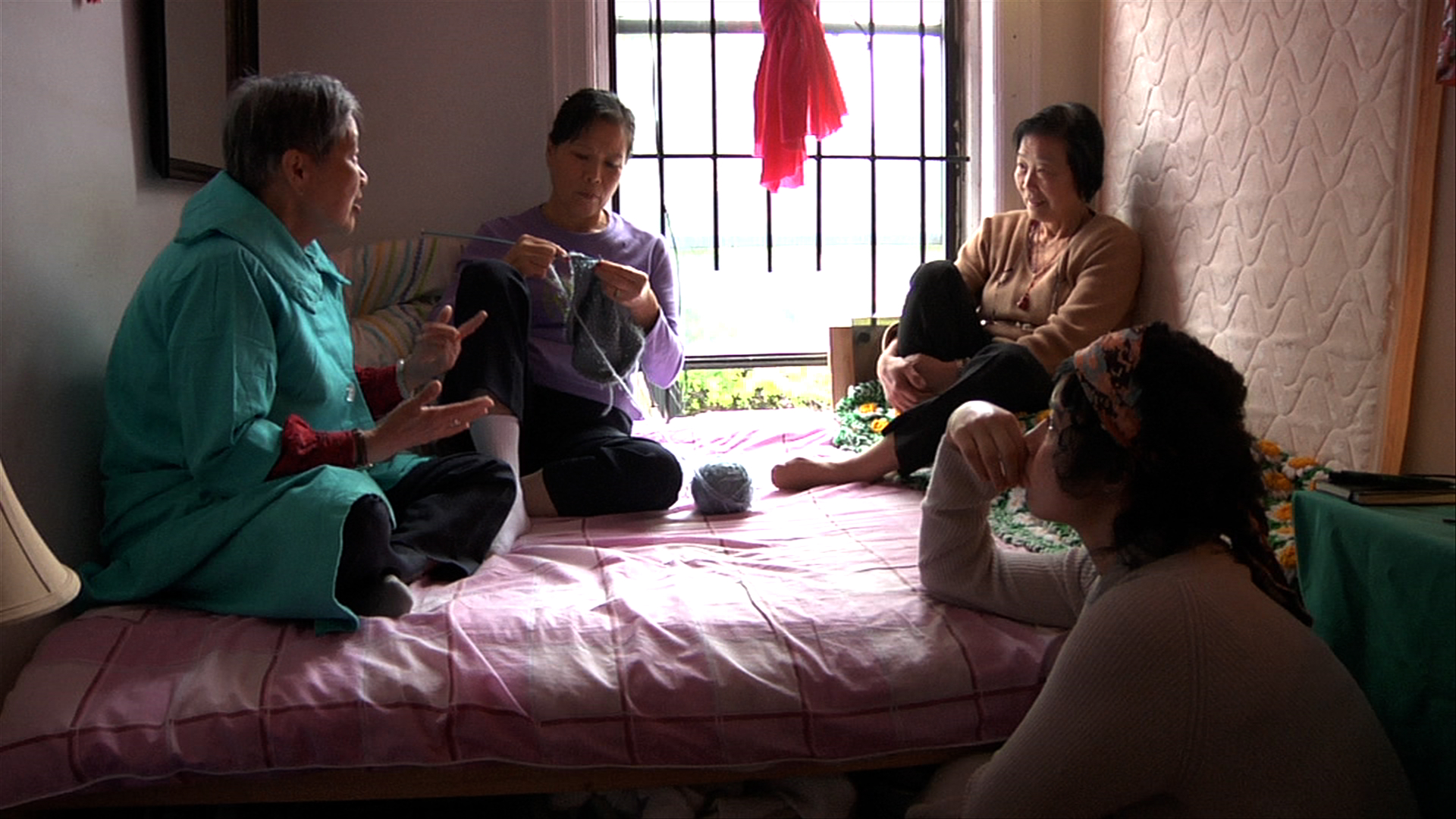
Still from “Your Day is My Night”. From left: Sheut Hing Lee, Linda Chan, Ellen Ho, and Veraalba Santa (“Lourdes”)
All photos courtesy of Lynne Sachs.
CV: When and why did you get interested in the shift-bed houses?
LS: About three years ago, I was at my uncle’s 90th birthday party. He’s lived in Brooklyn all his life. He told me that fifty years before, two major jets collided and crashed. (1960 New York Air Disaster) One of them fell on Flatbush Avenue in Brooklyn. I was horrified and felt bad for the people on the plane. But what about the people who lived there? He said it was hard to tell how many people died because there were so many “hotbed” houses. These are houses where working people, sometimes families, usually lived, but they only lived temporarily and sometimes they even shared beds. So I became interested in the “hotbed” as a particularly urban domestic space. I was curious about what it would be like for different people’s lives to intersect in that way. They weren’t people who had a familial or romantic tie, but they were people whose financial situation usually necessitated that they sleep in the day or the night, and yet they couldn’t afford the rent in New York. Then I discovered that this living arrangement is more contemporarily called a “shift-bed” house (if you type “hotbed” on Google, you’ll get x-rated things).
So I thought I would make a documentary about it. I went to housing agencies in Chinatown and quite a few advocacy groups. But they didn’t want to help me find people who lived in shift-bed houses. Why would they help me any more than they would help a curious reporter from the New York Times? And I kind of agreed with them. I didn’t want to be a voyeur. So I decided to do as much research as I could in order to recreate a shift-bed house. I started looking for performers by visiting theaters in Chinatown. But these were professionals, very polished and always busy. Most of these actors had lived here for a long, long time and they were very settled. They traveled a lot and with ease all over the country. They didn’t necessarily have any roots in Chinatown or connection to it. So that didn’t work out.
CV: How different was their performance from the kind of performance you were looking for?
LS: I am more of a documentarian. My way of filmmaking is all about process – “Tell me who you are and I’ll tell you what I’m trying to do and let’s work on something together.” But it didn’t work out with the professional actors because they actually wanted to be told exactly what to do.
Then I was taken by a Chinatown activist named by Paul to the Lin Sing Association on Mott Street, where he told me I could to find willing performers. Most of Lin Sing’s members are retired, so they have time. I happened to come during a karaoke contest. The place was packed. I said I am auditioning – as a documentary filmmaker I usually say I’m interviewing – I am making a film about beds. I didn’t explain any more than that. About 40 people signed up to come to audition and 26 people showed up. Working with a Chinese translator, I interviewed every one of them but I only asked them about one thing. I said, “Do you have any interesting stories about beds in your life? Did you ever have to share a bed? Did you ever live in a really crowded apartment where there were many beds? I taped the interviews with these 26 people. It ended up that seven people actually had these stunning and haunting stories to tell me. I immediately had the feeling that they had never told these stories because clearly these were very particular moments in their lives. I never said, “Tell me your whole childhood”, or “Tell me your first job”, or “Tell me about your school”. By paring it down to that specific thing, I landed on some of the most fascinating, historically important insights into a very complicated period in Chinese history.
CV: What research did you do that lead you to the Chinatown shift-beds?
LS: I watched an informative documentary about shift-bed houses by Peter Kwong, a professor of Urban Studies at Hunter College. I also read about the phenomenon in a more sociological sense, but I didn’t really read any whole books about it. In fact there seems to be very little. And then in the New York Times there were pictures by Annie Ling a photographer who spent a year taking pictures in a shift-bed house on the Bowery. I saw her images and then contacted her. We have remained in touch over the years and she came to one of our live performances at University Settlement on the Lower East Side. In November of 2013, she will have a one-woman exhibition of these images at the Museum of the Chinese in American and I will screen “Your Day is My Night” in conjunction with her show. There’s been a nice bonding between the two of us as artists.
CV: I find it interesting that you set off exploring an urban existence, which is supposedly in the present tense. But, as you said, the intersections within this space have become a knot for different personal histories. That is almost therapeutic.
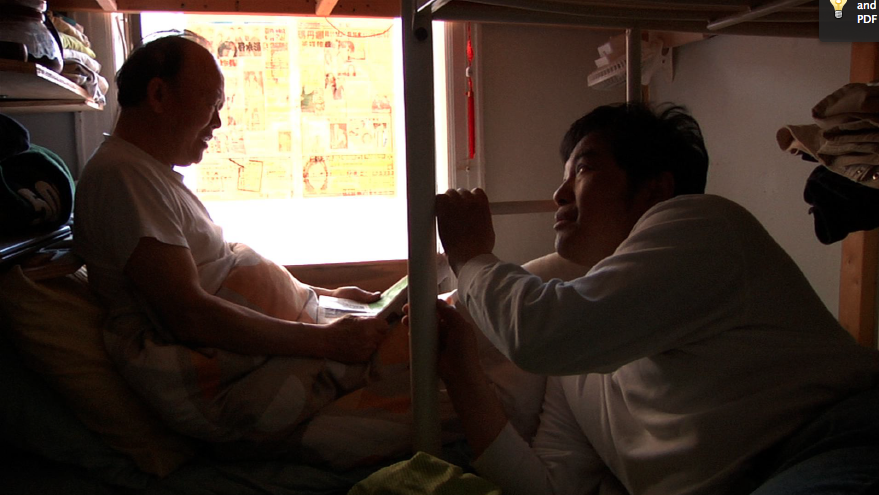
Still from “Your Day is My Night”. Kam Tin Tsui and Yun Xiu Huang
LS: Most of the people in the film have children and grandchildren, but they have never wanted to share this kind sadness with them. Maybe it’s something they want to forget, but they might not be able to. It is the same when you are talking to a Holocaust survivor. They went through similar experiences to what Chinese people went through in the 1940s. Interestingly, the disturbing stories that you hear in the film surprised Jenifer Lee, one of our translators. She’s from Taiwan originally and she said that she’d never heard about so many terrible things happening as early as the 1940s in China. Things like gangs breaking into someone’s house and beating up parents in front of their children. People were not really talking about this kind of violence in history very much. Still, most of our performers did bring their kids to the show. To me, this is important, because they were proud as performers and a lot of them wanted to reveal their tragic stories to their own families.
CV: Are the performers all living in the shift-bed house?
SH: Within the world of the film there are these scenarios that we set up with the help of the performers. At some point in their lives, everyone has been touched by shift-beds or a similar experience. But for some of the performers it is not necessarily the case right now.
LS: You hear the story in the very beginning. It is a story from a young man who talks about sometimes sleeping in his own bed and sometimes sleeping with his dad. That’s his story and he lives in a shift-bed house. I didn’t put him in front of the camera. I don’t think he wanted to be. He was speaking openly about his life right that moment. Some of the other stories required that we create more of a narrative context. These people don’t really all live together, in that apartment, right now. But they bring their stories to this place as collaborators in the film. So that’s why we call it a hybrid of fact and fiction.
For the last two years, we’ve been shooting video and film with our performers in a couple of different shift-bed houses, sometimes day after day, sometimes weekly. Then there will be a few months when Sean and I are simply editing, not shooting at all. The performers and us, we’ve eaten so many meals together. What really distinguishes this from other documentaries I’ve made is that sustained connection, where nobody ever lets anybody down. In any intense art project you work on, if there is one person who misses a meeting or a film shot, everyone else feels let-down. That almost never happened with this project. We work as a collective.
CV: What was the creative process like?
LS: I took notes at the first audition, which was with a lot of people in one room at the Lin Sing Association. I’m not someone who’s so comfortable telling people who audition “I want you, but not you”, “You’re attractive, you’re not”, or “You’re the right age, you’re not.” During that first interaction, I was just looking for people who have a story to tell, One of the people who auditioned was Catherine Ng, a recent immigrant from Hong Kon who immediately began to help because she could speak English. She’s been involved in the production as a translator and production manager ever since. I like this flow between the people involved in the performance and the people involved in the production, the shift between being in front of the camera and behind it.
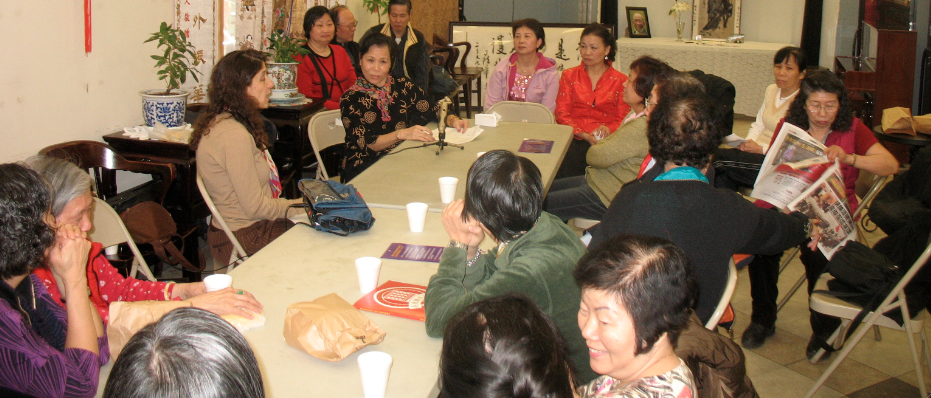
Production still of “Your Day is My Night”. Audition at Lin Sing Association.
Then we did a second set of interviews and the Puerto Rican playwright Rojo Robles came with me. We listened to the interviews and recorded them. We took the “bed” part of each story and distilled it down to what you heard and saw in the film. And then we gave it back to them and they memorized their parts. That actually was interesting – the performers corrected things, not just grammatically, but facts. For example, Ellen Ho has a story in the film, where she talks about being given an egg when she turned 14. So I thought, someone gives you one egg, big deal! So let’s just say they gave you twelve eggs instead. When Ellen read this in her “script” she burst out laughing. She said, “We were really poor, and one egg was enough. One egg was my birthday present. You can’t put twelve eggs.” Things like that happened all of the time. Our performers made sure that their monologues spoke honestly about their experiences.
CV: Why did you put Lourdes, the girl who wants to get away from her life in Puerto Rico, among the Chinese immigrants in this shift-bed house? Her appearance and her language are both an oddity to the memory-scape and present existence of that house. But on second thought, it is a real New York experience.
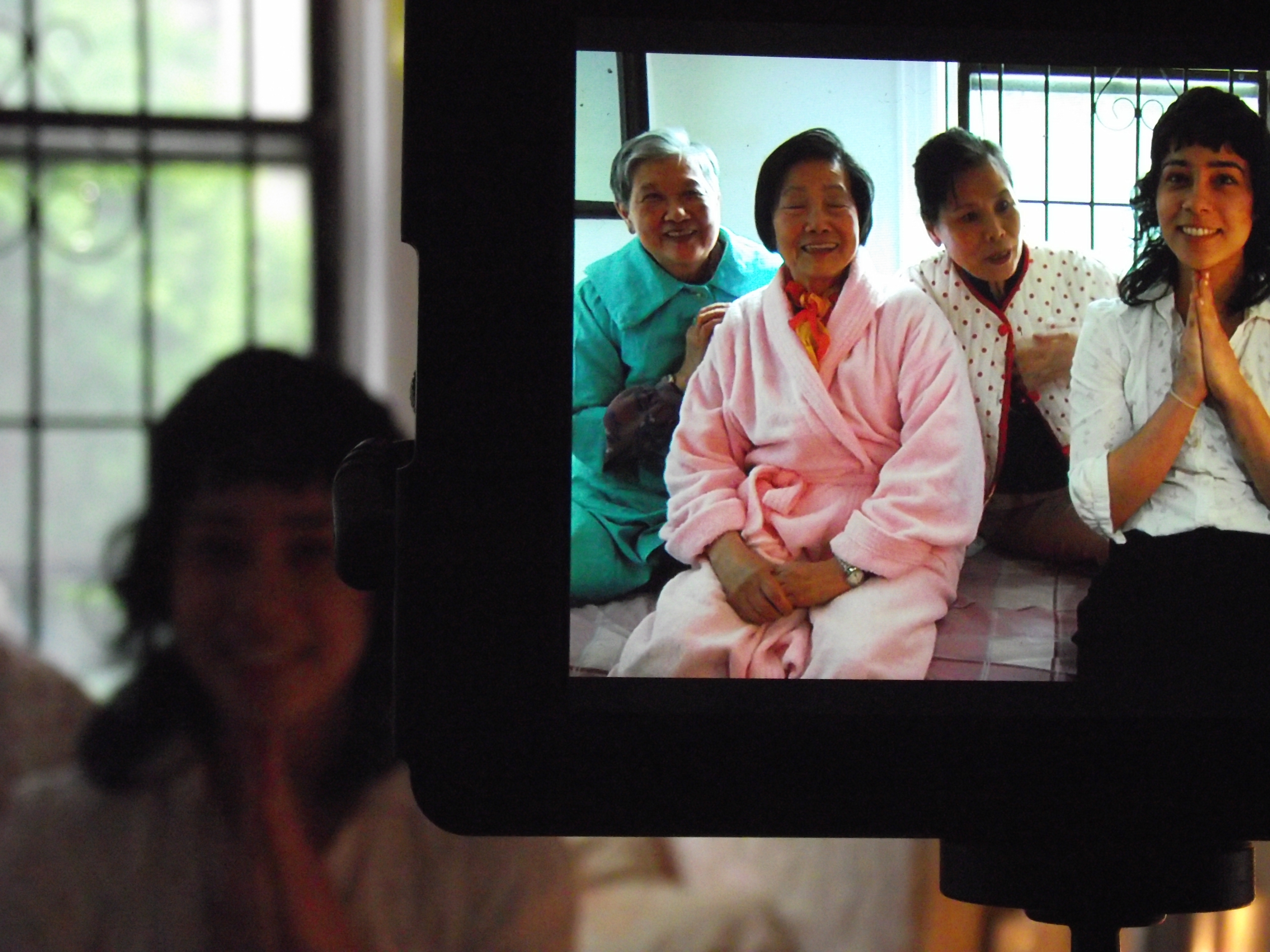
Production still of “Your Day is My Night”. Sheut Hing Lee, Ellen Ho, Linda Chan, and Veraalba Santa
LS: One thing that I didn’t want to happen in this film was to portray either the shift-bed houses or Chinatown as isolated enclaves that didn’t exist anywhere else, because I’ve sort of seen that in other films: “This is a community. It is so tight, so impervious. Nothing comes in or goes out.” I wanted to say that in 21st Century America, life is more porous. People have accidental interactions that affect them, and so I felt like bringing in not just another language, but also another person with a slightly different immigration experience, would add to that conversation. I also felt that for an audience, it broke the snowglobe feeling of “I’m looking in, but I cannot go in.” That would imply that Chinatown was a kind of hermetic space. So I thought that by having a new person in the apartment who’s a little bit wide-eyed, who wanted to learn from her older “roommates”, we could offer the audience the opportunity to become more involved. I wanted to make her character less at ease in the household, to have her own awkwardness.
Cultural historian James Clifford writes a lot about travel and immigration. He says that people look at a European traveler as a person who wants to see the world, become changed, and then go home freely to write a perfect memoir. But people don’t look at other immigration experiences that way – people who are forced to emigrate for financial reasons, for example, They too keep their own forms of personal memoir. In “Your Day is My Night”, I wanted there to be a dialogue around the immigration experience to allow the older people to speak about their struggles and their epiphanies, while the younger woman doesn’t even know why she’s traveling, why she’s exchanged one home for another. Her travel was more awkward, because she’s sort of trying to find something, without knowing what that something is.
CV: Is she based on a true character?
LS: Lourdes is played by Veraalba Santa, who is a Puerto Rican actress who has recently moved here. She is the only person in the film who does not use her real name. This is significant and made clear in the film. Her presence is more of a narrative construction.
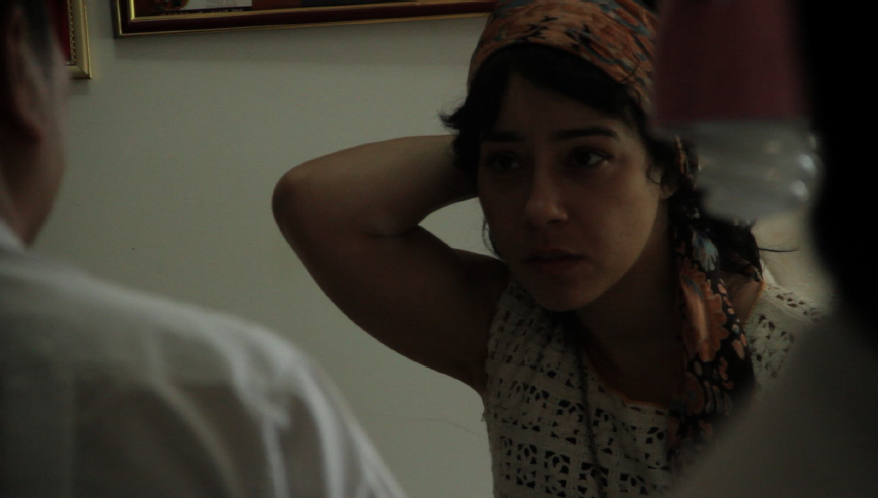
Production still of “Your Day is My Night”. Lourdes (played by Veraalba Santa) talks to Yun Xiu Huang.
CV: There was a sequence of Lourdes and Mr. Huang standing along the river, right after Mr. Huang says he wants to “chase love”. In the second half of the film they are seen together more often. What does this suggest about their relationship?
SH: Mr. Huang is the youngest member in the household and the most fun character in this film. We just put them together and the chemistry occurred. They just started talking about how they came to America. Mr. Huang struggled very hard to use English in the scene. It comes off so well. It just happened that way. We shot a few takes. So the scenes in the apartment when they are talking before the dance performance, that was a scenario we set up; going to the performance was a kind of documentary. We didn’t know what was going to happen. They sat there talking during the performance, leaning in close. I was across the room shooting with a long lens. They just did what seemed natural to them. But the inclination of a relationship was never our intention. The chemistry came just from when they are talking. I think that speaks to the nature of this film that some scenes are shot in multiple takes and some scenes are pure documentary, where we had some scenarios and they were just themselves. The Chinatown dance performance with cowboy hats was something that was happening that day. Several of members of our cast were actually performing on stage. It worked well because their performing on stage referenced back to their performing in this film.
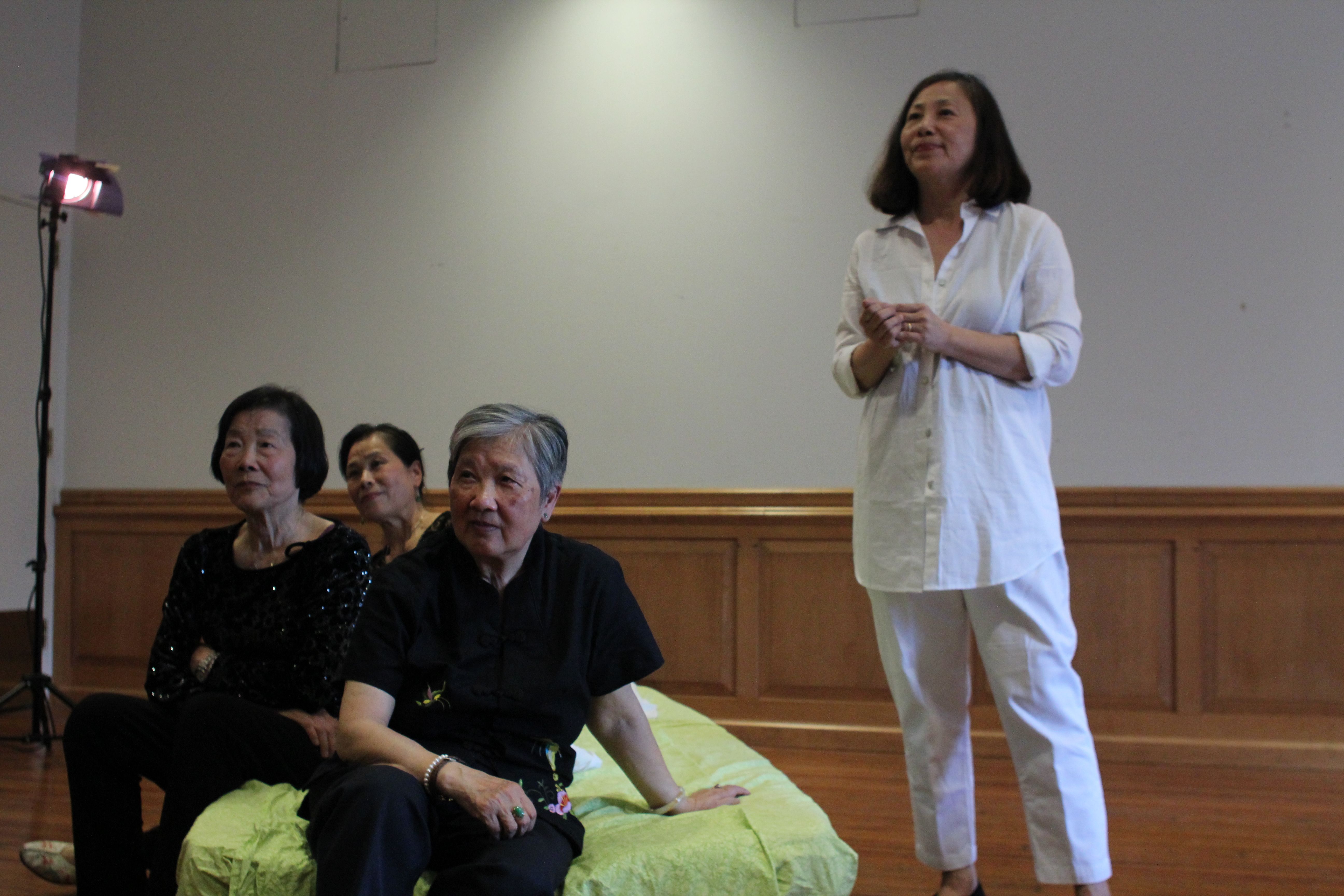
“Your Day is My Night”‘s performance at New York Public Library in April, 2012. Ellen, Linda, Sheut Hing Lee and Jenifer Lee.”
LS: Part of it is that, when you are making a film, you spend a lot of time with these people. We all worked so hard on this project. We all care about it, like a labor of love. That kind of passion comes from the fact that all these people are used to working on something that is creative. They are all in dance groups, they like engaging with the world through creative experience. They don’t mind the commitment.
CV: What about the poem at the very end? It’s in Spanish, a detached language to the scenarios, but also a relevant, yet a-historical glimpse at the conditions of their existence.
LS: I really liked this poem called “Sleepless City: Brooklyn Bridge Nocturne” by the 20th Century Spanish poet Federico García Lorca. In 1929, Lorca wrote a beautiful collection of poems about the one year he lived in the US. He wrote about the modern buildings, the loneliness, the alienation, all about the urban life that was new to him. These are the aspects of the city that fascinated him. For me, he seemed to write about the secrets people carry in their bodies, the weight of your past on your shoulders. And this holds especially true for immigrants. But there’s another side of his story. When Lorca went back to Spain and during Franco’s dictatorship years later he was killed by a government militia because of his leftist leanings and also perhaps because he was gay. He lived in a state of oppression that I found parallel to the situation the Chinese performers in the film speak about. I thought about putting all of that backstory in the film but I didn’t. I hope the poem carries its own weight without that background. Lorca was seeing this city with very fresh eyes and that was interesting.
Oh do you know who Murong Xuecun is? When Mr. Huang is watching a television show on his laptop, you can see a book on his bed. It’s translated as “Chengdu, Please Forget Me Tonight”. From what I have read, Murong is a super popular novelist in China. His books are very gritty, they portray hard living in Chinese cities. And now his stories have made into TV programs. By watching these shows in the film, Mr. Huang could have access to young people’s lives in China. We see the book in English on screen, as if Lourdes has read it. We don’t reference it specifically in the dialogue of the film, but use it as a provocation. I am hoping some people will recognize the book and get a kick out of seeing a reference to this iconoclastic writer in our movie.
CV: There is a lot of translation on many levels in this film, between different languages, and between different media, script and body, stagedness and spontaneity.
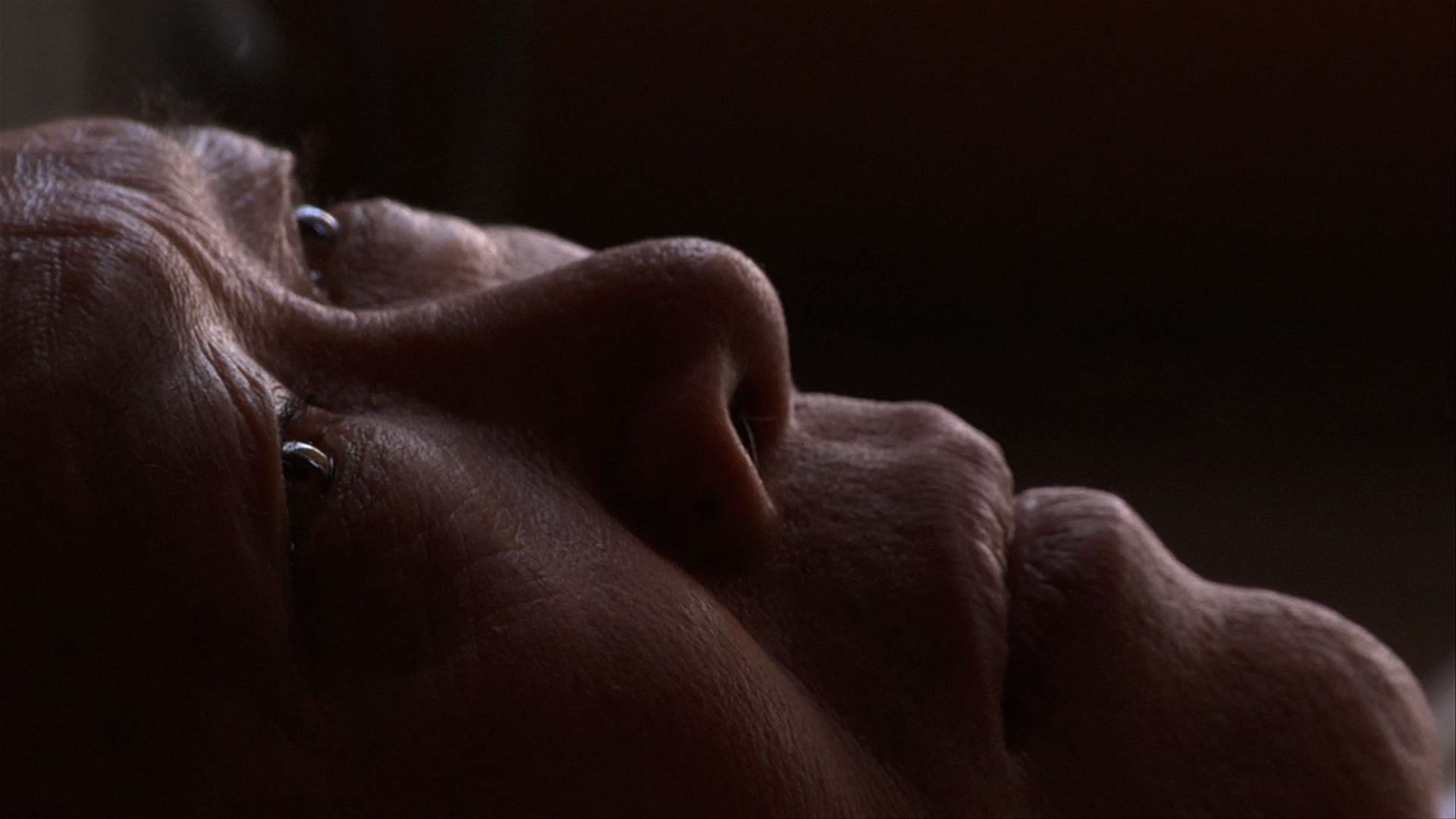
Still from “Your Day is My Night”. Character in photo: Kam Yin Tsui.
LS: Translation is a big part of this film. Jenifer Lee and Catherine Ng helped us a lot during throughout our two years of production. Then we would sit in front of the computer screen editing, and there would be another layer of translation. We brought in Bryan Chang, a Chinese-American video editor, to go through the dialogue again and make it just right. He’s a literature major. He was able to take the expressions we had been translating literally, word for word, and make them more poetic. But he doesn’t speak Cantonese. So sometimes we needed to sit with Bryan and Catherine. The whole process was so complicate! But it was also nice because Bryan sometimes heard things that we didn’t even know were there. There is a scene when Sheut Lee, Linda, and Ellen are in the kitchen right before Lourdes walks in, and they are talking about “If you are not good on stage, you’re going to be thrown off.” We had never translated that, because that is what we thought of it as “small talk”, and he said: “No you gotta translate that!” And now that conversation helps to build the more self-reflexive levels of the film by drawing attention to the performative aspects of the scenes.
CV: This kind of collaboration can never happen without trust. It makes the film very convincing and truthful on an emotional level when it plays with fiction and non-fiction.
LS: Vietnamese filmmaker and theorist Trinh T. Minh-ha has been very influential on my filmmaking. I studied with her in graduate school in San Francisco State University’s Cinema Department and then worked with her for some years doing sound recording and editing. In the mid 1980s, she was the first filmmaker I knew about who explored this play between performance and documentary. I like the idea that sometimes you are performing your own life, instead of the idea that everything has to be absolutely fresh or verité, you get to ponder and shape the experiences of your life. These days, I feel audiences are more interested in the hybrid process than “This is journalism and this is exactly the way it happened.” Even ten years ago I think it would be a little bit harder to pull that off. Even if they all had a text to memorize, most of our performers, they didn’t exactly memorize. They went their own way – they definitely used it as a skeleton and built their own thing. We all know it’s hard to memorize. Our translator Catherine would often whisper to me during shooting: “They abandoned your script a long time ago!” Of course, I didn’t know since I could not understand what they were saying, but then again I liked seeing them find their voice by putting their stories back into their own words.
CV: Did you decide in the first place to insert the performances in the film?
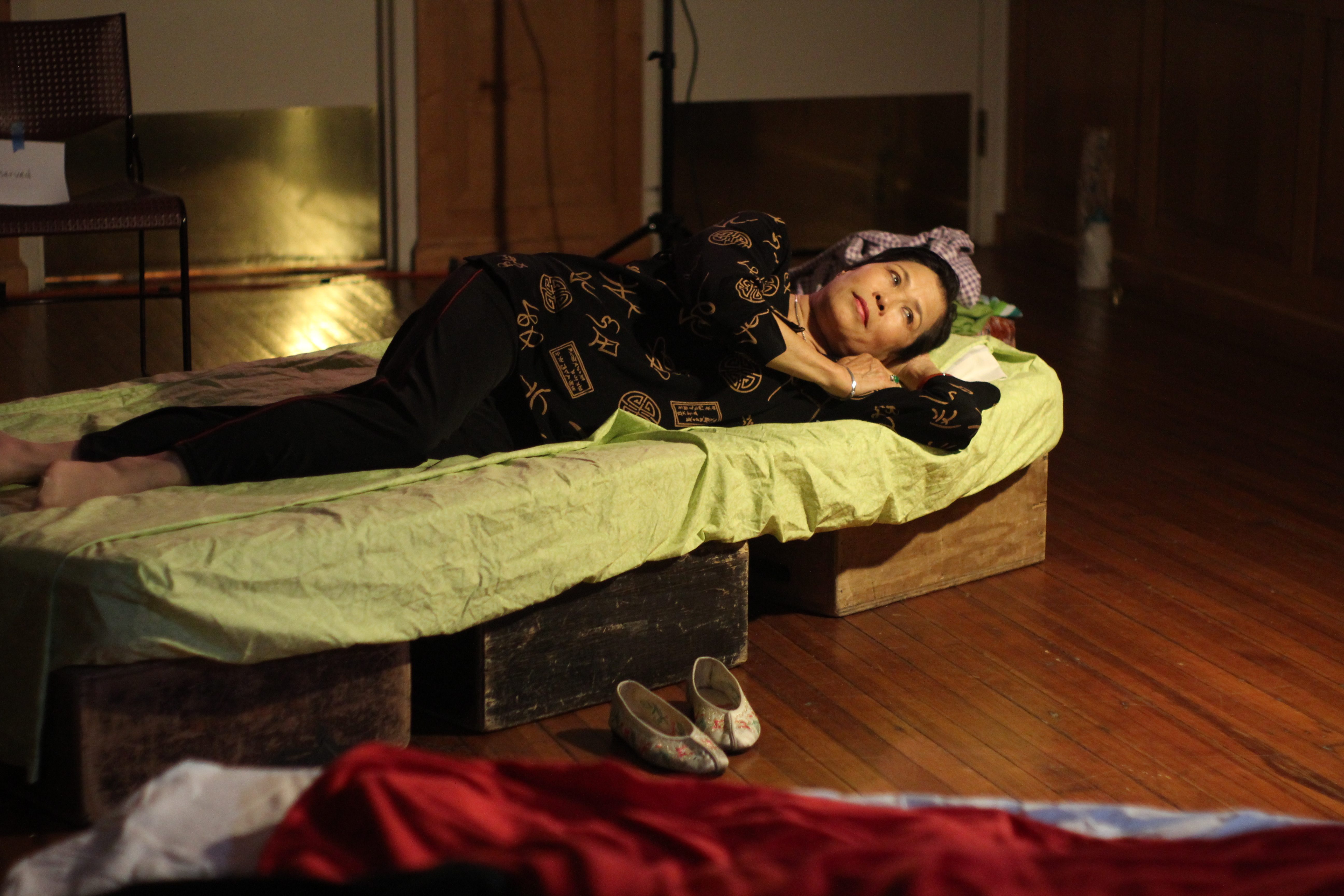
“Your Day is My Night”‘s performance at New York Public Library in April, 2012. Linda’s performance.
LS: Originally the film was a little bit more narrative. For example, we had this whole part where Mr. Huang disappears, because Lourdes originally tries to get him out of Chinatown after he claims that he never leaves. They walk across the Manhattan bridge and she says: “I have to go to work”. When she leaves to go to work, he’s never seen again. It didn’t work in the film. It turned it into a narrative film that had a forced story and people judged it on the acting.
Far into our production, as I was documenting one of our live performances, I thought “This is really expressive and totally non-verbal, why aren’t we using it in the film?” Again, the idea, the process, revealed itself, whereas the more plot driven story was what I was forcing on them. It was artificial. So I took out all of that and allowed the film to become more improvisational and intuitive. This switched everything. We spent a year edit the other way and then just threw it all out when we realized how lucky we were to work with who people so confident about their bodies, very willing to go on the stage and move freely. They had that ability and confidence.
SH: We found how evocative it was to see this live switching of beds and we started shooting it for documentation, and then we reshot to fit it in the film. It was all part of the process of working out things, trying new things, and reworking them again. When we took parts of it away, other parts came more to the forefront.
CV: The performance helps a lot with the film’s pacing.
SH: For a film that has a lot of heavy dialogues, having non-verbal moments allows the audience to reflect on the stories, because it’s a lot of stories in a row. We had these quiet moments, what we call “troughs”, while you are watching you settle down to a performance scene, be it musical or non-verbal, and you are given the opportunity to reflect back on these very powerful stories you heard, that you may not have comprehend the scale of before.
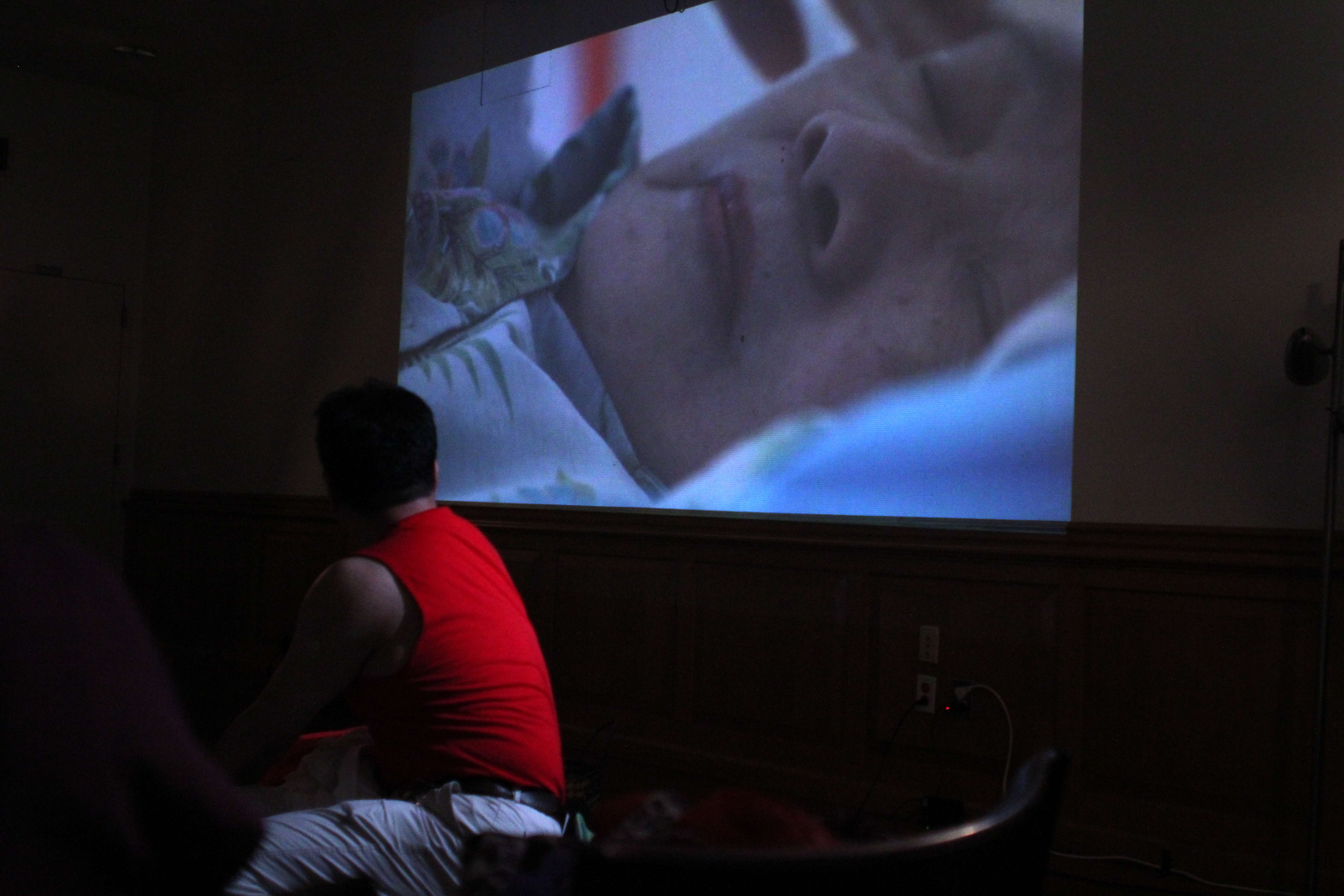
“Your Day is My Night”‘s performance at New York Public Library in April, 2012.
LS: I think scale is a good word, because the film is comprised of a series intimate moments, but they are also about grand historical periods as well, and to integrate the micro and macro well takes a little time. You cannot just keep giving the audience more and more information, especially since we didn’t provide the audience with much historical context. The performers use dates, but they don’t talk about Mao specifically. They never criticize the government in a direct fashion. So the audience has to bring to it what they want. I think any kind of documentary needs some quiet, nonverbal moments to integrate all that. We were looking for two kinds of rhythm: one come out of the form, the given takes, the shift between dialogues and sound effects. Then it’s the mental rhythm between information, poetry, and feeling. That rhythm took a while to find.
CV: Sean, how did you find the rhythm in your camera movement? It is intimate and intuitive, seemingly not with too much depth of field, but explores the space very effectively.

Production still of “Your Day is My Night”. Sean Hanley maneuvers in the room with the camera.
SH: Myself and the other cinematographer Ethan Mass, we were almost forced by the environment we were shooting in, to always reinven our the camera work. What we ended up dealing with is getting as close as we could. That lead us to be in the beds often while we were shooting in the room. In the beds, with the cast. sometimes out the window, shooting in, laying down, standing up. We had to be as present as we could. That’s why the cinematography is so close and intimate, maybe claustrophobic at some points. We tried to get as much coverage as we could, but we then decided that these hand-held intimate moments were more effective.
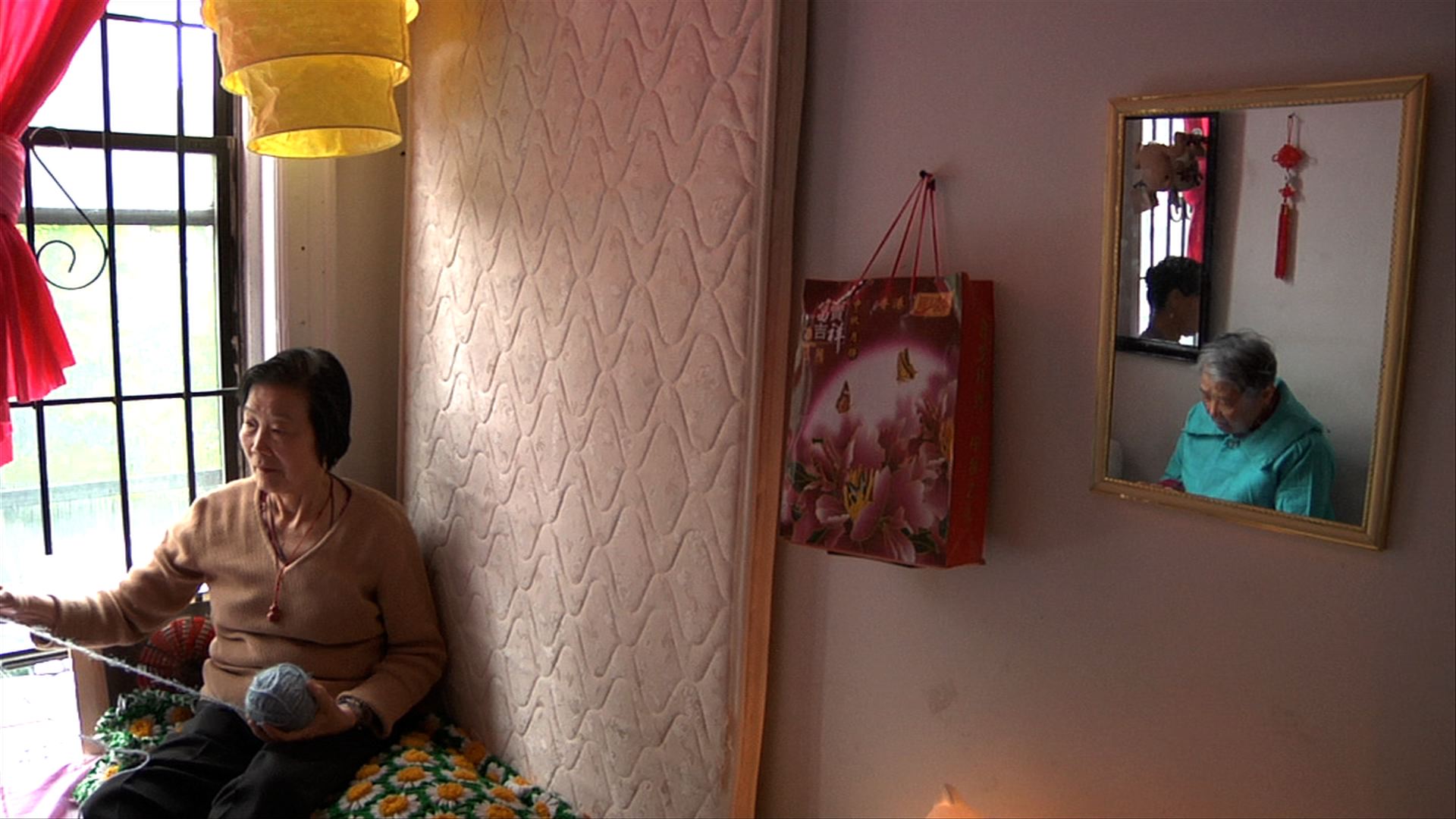
Production still of “Your Day is My Night”. Mirrors that reinvent the space.
One of the things Lynne was really striving for was to shoot through mirrors, because it created this illusion of a different space. So in Ellen’s monologue, when she’s brushing Linda’s hair – I shot entirely through a mirror. You don’t really notice but every now and then you can see a little bit of the edge. And during the wedding scene, Mr. Huang was shot through a mirror too. It diffused the image a little bit because there were some grain and dust on the mirror. This gives it a magical quality. Every opportunity we could, we tried to do that because again it would reinvent the space.
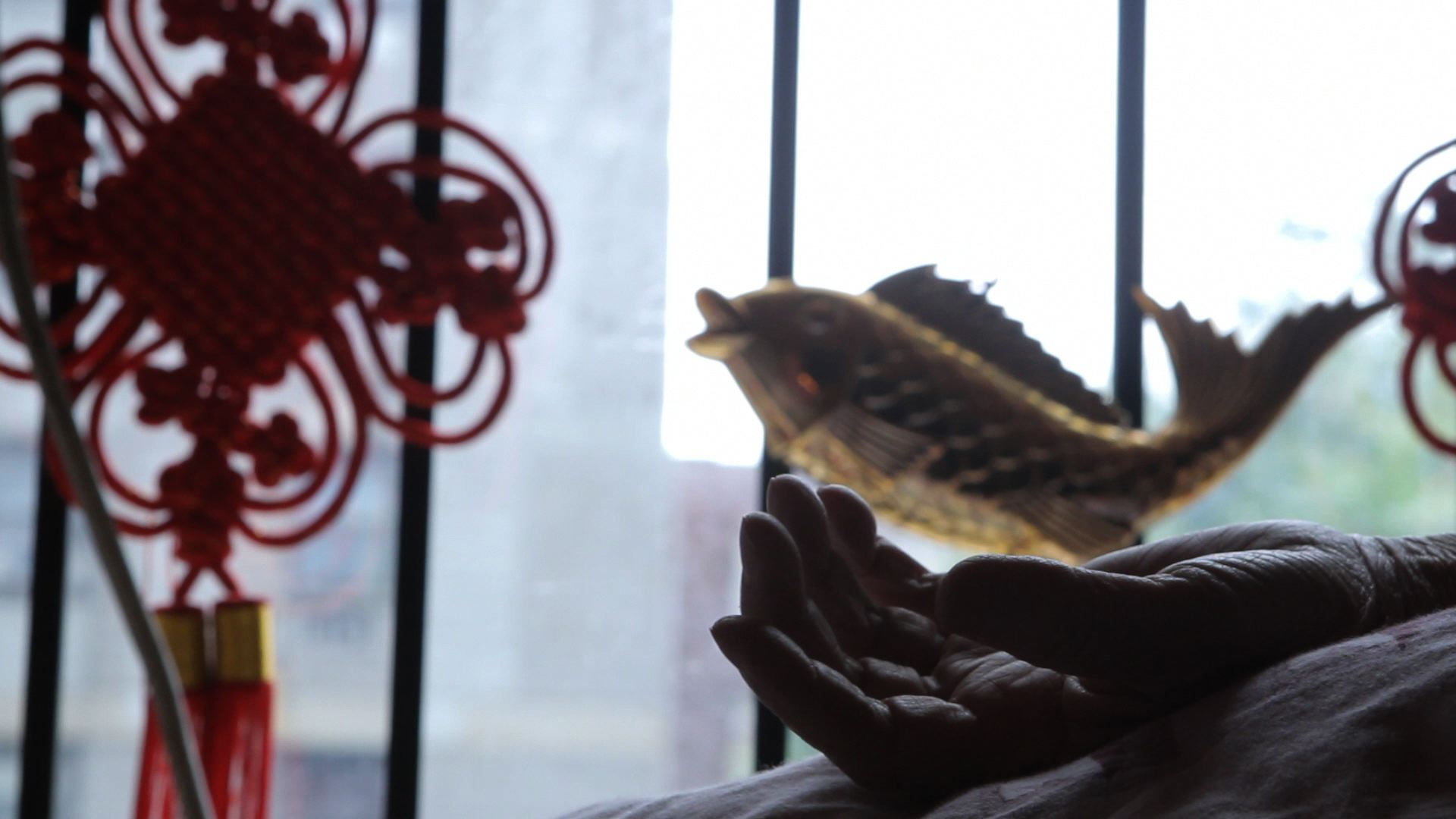
Still from “Your Day is My Night”. Ellen’s hand on bed.
LS: Because of the tight quarters, some parts of your body cannot move. What you can move more freely is your hands. In this circumstance the performer’s hands became two bodies. They are interesting and sculptural. So we tried to use the hands and the sheets as two kinds of landscapes. From the very beginning this was a visual plan we had. I always wanted the sheets to become like caverns, to have a feeling of adventure over the sheets. There was one shot of Mr. Huang’s pink sheet right after his first monologue. I wanted it to feel like the Grand Canyon, or the Steppes in Eurasia, something very far out there.
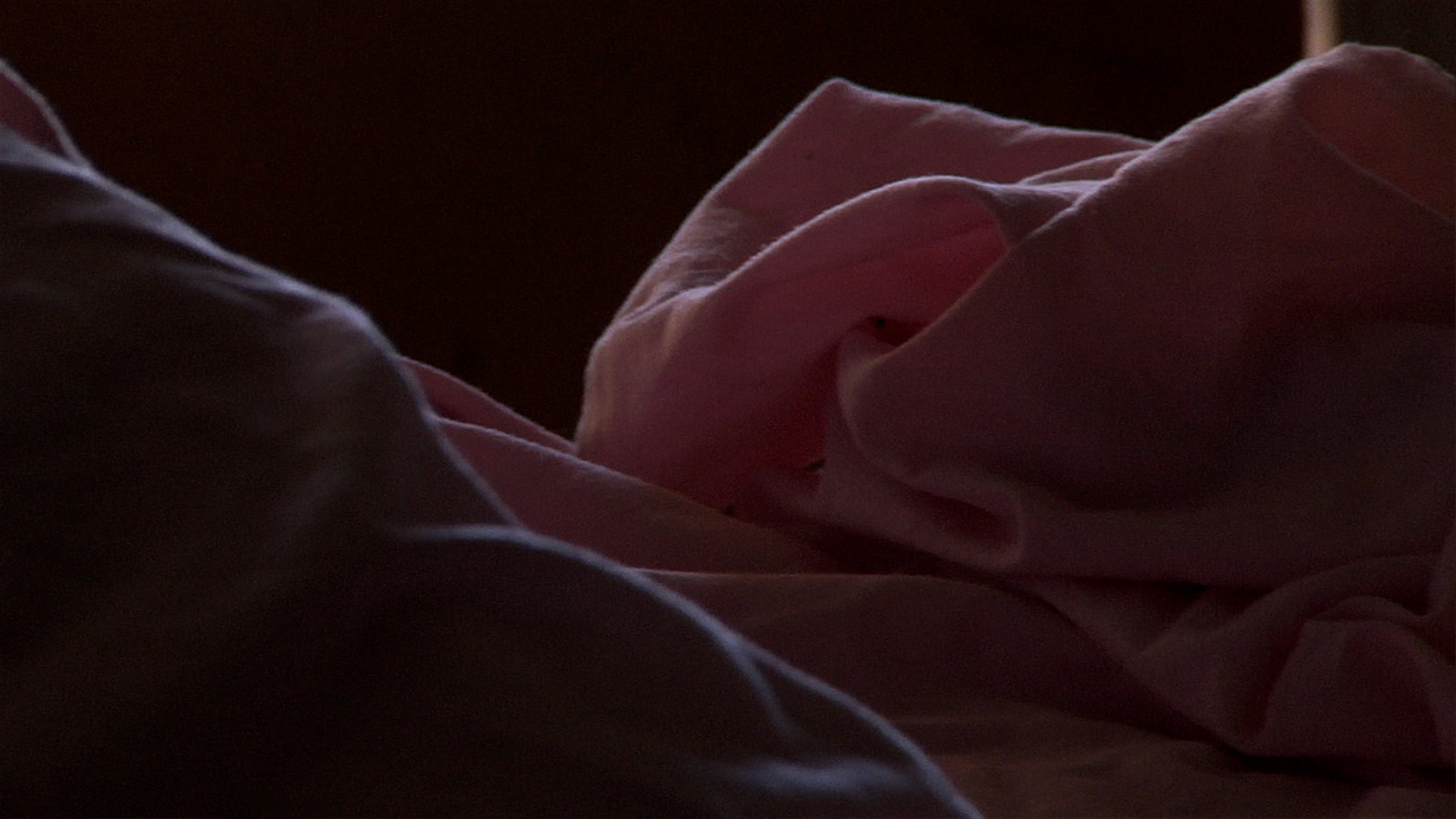
Still from “Your Day is My Night”. Pink sheet as the Grand Canyon.
CV: It is not the first time Lynne has dealt with a foreign language. But is it your first project you’re involved in that speaks another language?
SH: Totally. It provided a challenge while we were shooting because we didn’t necessarily know what they were saying and when. So we would ask whoever’s with us to translate and we had to be on our feet with our cameras, trying to capture the right sentences. We also worked it around in the editing process. But what I really was able to do was start to read the body language, especially when it was completely unrehearsed.
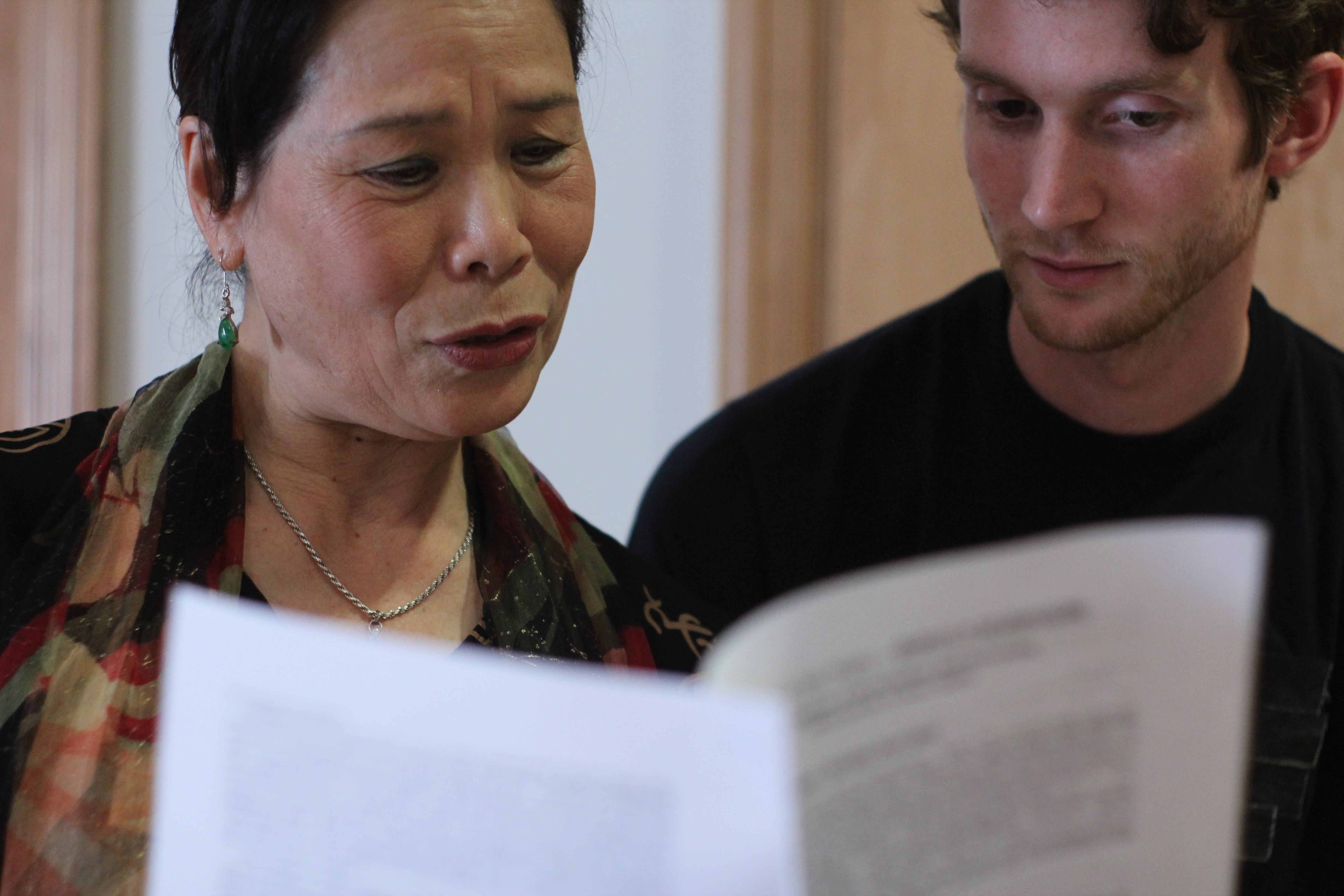
“Your Day is My Night”‘s performance at New York Public Library in April, 2012. Linda and Sean look at the program.
LS: One moment when we really felt that it was a collaboration was when we went to the second shift-bed house that Mr. Huang visits. Linda Chan, one of our performers, found the house for us. In a sense, she became a co-producer with us. Nothing was rehearsed in that house. Mr. Huang just walked in. By that point we’d already worked with both Linda and Huang for over a year, and Linda knew exactly what I was looking for. Once the men started to talk, she would whisper to me “It’s good!” or “This is not interesting!” She knew whether we were going the right direction. This was the moment when I realized that she had transitioned into an integral part of the production; she was now a real collaborator in our filmmaking process.
CV: How did the performers engage themselves in telling and acting out their stories?
LS: The first time we put on a live performance was in an old hospital that had been transformed into an art space in Greenpoint, Brooklyn. After the show during the the Q&A, our performers were very uncomfortable with answering personal questions, like “How do you feel about this production?” The idea of expressing their own opinion made them uncomfortable, especially In front of a live audience.” At the time, I didn’t understand that they weren’t used to expressing their candid opinions in front a public. They were always saying, “Whatever Lynne says is fine.” But over the months, when we put on other shows, they were much more comfortable. In University Settlement, Mr. Tsui, who used to be very quiet, stood up and talked for about fifteen minutes. The change from the first time was amazing.
SH: We asked Jenifer why they were quiet and what was going on. She said they were not used to being asked their opinions. Then in a smaller setting at the Tenement Museum, the audience asked more about specific questions about their lives. That was the first time they were given the microphone. Suddenly everyone felt: “This is my moment, so now I can really tell my story.”
LS: There were a lot of Chinese people in the audience, people with their grandchildren. I think the real connection went way beyond the movie. At last our performers were comfortable telling their stories in front of an English speaking audience without being given the permission to do it, It was very exciting. From what Jenifer tells me, people growing up in China in the 40s and 50s, were not encouraged to express their opinions publicly. That’s still a legacy they’re dealing with here.
CV: What was the audience’s reaction to the previews and performances?
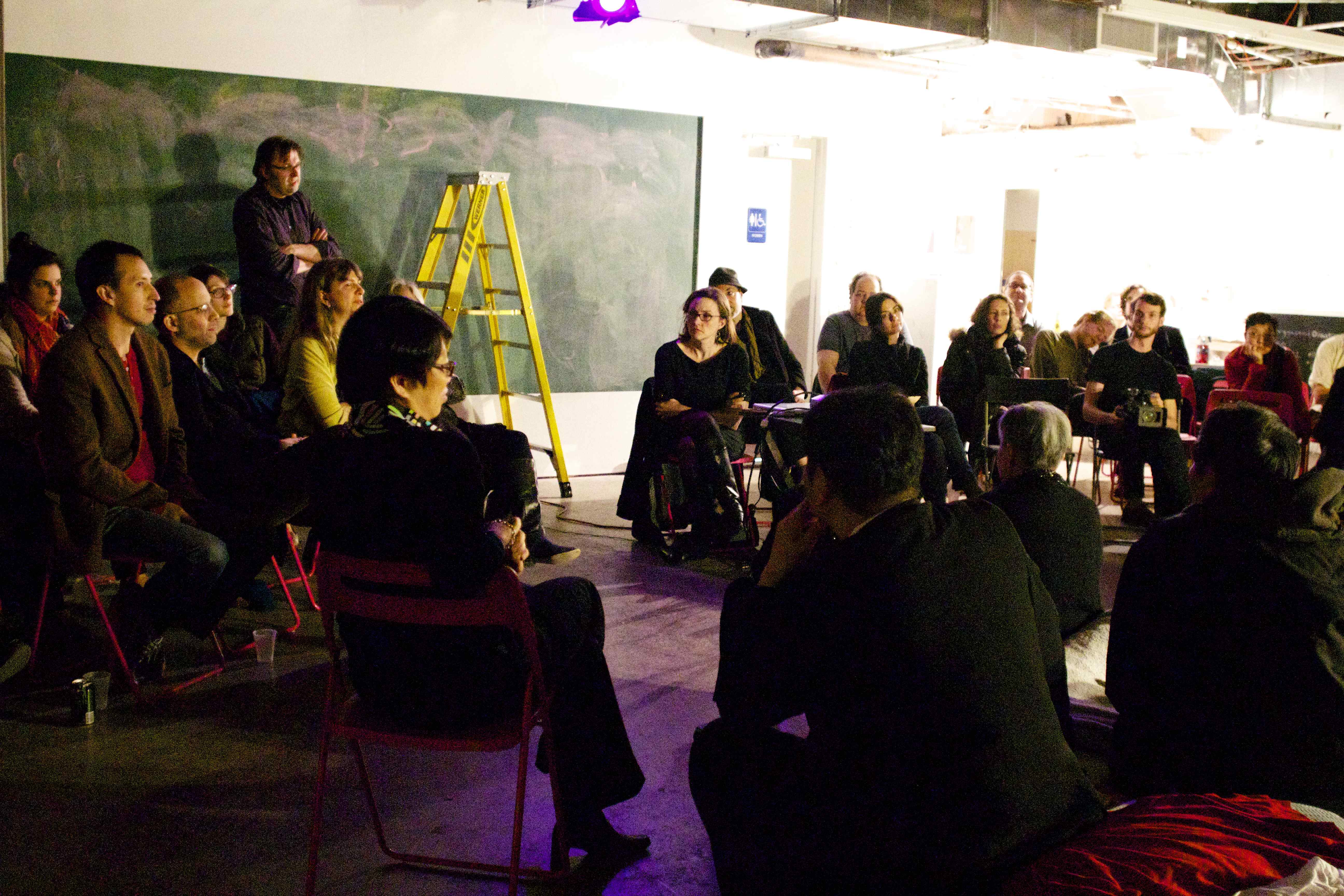
“Your Day is My Night”‘s performance in Brooklyn, 2012.
LS: The first preview screening was in Washington D.C. at the National Gallery. The audience asked good questions and seemed very positive. We really learned more here when we did the live performances in Chinatown and at University Settlement. Each time we learned a little bit more about what we were expressing to the world.
SH: We’ve always been quite curious what the Chinatown community has felt. We’ve put on our live show twice in Brooklyn and once in a Chinatown environment, before we did it at the University Settlement. Even if the first time we did it at the Chatham Square Library in Chinatown – it was our first time showing it to a Chinese audience. I don’t know if we walked away knowing if we understood yet, until we had a more intimate conversation about it at the Tenement Museum. A lot of people from Chinatown and the NYC Chinese American community attended that show. There was one woman who brought her husband and her son. During the Questions and Answers, she explained to the whole audience that these are the stories her grandmother didn’t want to tell her, but now that she’s seen them in the film, she can tell them to her son. She gave this emotional story and it was encouraging to us to realize: “OK, we’ve got the tone right.”
CV: Do you have plans to have this film screened in Chinese speaking regions?
LS: We are looking for advice! It’s really hard to find any international film festivals in China. Museums would be great as well.
SH: We just submitted it to the Hong Kong International Film Festival.
LS: And we are working on our website. We want it to be searchable in both English and Chinese. It would be a shame if it is only searchable here.
CV: Do you feel they will be willing to let people back home see what they are doing here?
LS: You have to ask them. I think so. They haven’t seen the finished film yet. The first time they see it, it will be at the Museum of Moderns Art here in New York. Essentially they know what their part in it is like. But I haven’t quite asked “Would you feel comfortable having this film shown in China” per se. We are not even close to that yet. I don’t want to cause any problems.
CV: Speaking of problems, there was a curious appearance of Ai Weiwei’s sculptures in the film.
LS: That was the summer of 2011. His Zodiac animal sculptures were up temporarily at 59th St and 5th Ave. We invited Mr. Huang when we went to see these sculptures. We told him that Ai Weiwei was controversial and he didn’t want to go because he didn’t want his pictures taken there. That’s exactly what happened. I can’t tell you if he knows who Ai Weiwei is, but he didn’t want any problems because he was working on his immigration.
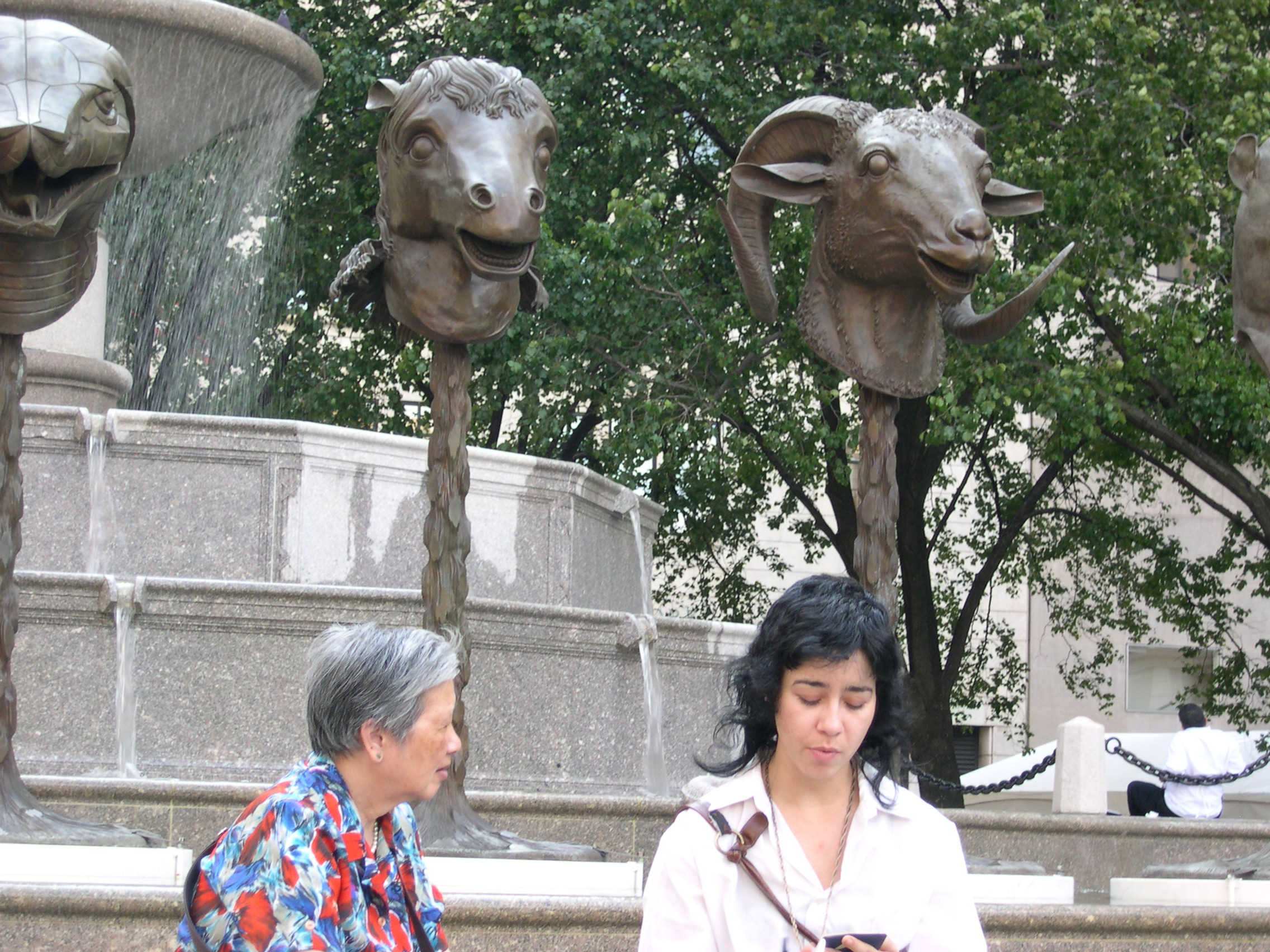
Production Still from “Your Day is My Night”. Sheut Hing Lee and Veraalba Santa in front of Ai Wei Wei’s Zodiac sculptures.
JL: You know, this is their world. They don’t go outside Chinatown. When you tell them MoMA, they are interested. But when I tell them “Invite your friends”, they say their friends don’t know how to get there.
LS: Unless we can hire a big van! Bus! Let’s talk about that!
CV: What do you think this project can bring to the immigrant cultures in the City?
LS: That was not necessarily my goal. In this city we have so many cultures. So many times we walk by someone and we don’t look at their eyes, because we don’t know how to look at their eyes. We see them moving and what we say to ourselves is “This is an old person”, or “This is a person from Africa”. We know we don’t speak their language and so we actually stop thinking that they have a very specific story. And I think the story of Chinese immigrants here is kind of opaque for most Americans. Many Americans just think of Chinese people coming here, starting a family. They think about those success stories involving Chinese young people in Stuyvesant High School. This is what the Americans look at. They look at the success. They look at the results. They don’t look at where people are coming from that much. So hopefully our film opens up this way of thinking, making it more complicated and perhaps more meaningful.
Filmmakers’ Bios:
Lynne Sachs makes films, videos, installations and web projects that explore the intricate relationship between personal observations and broader historical experiences by weaving together poetry, collage, painting, politics and layered sound design. Supported by fellowships from the Rockefeller and Jerome Foundations and the New York State Council on the Arts, Lynneʼs films have screened at the Museum of Modern Art, the New York Film Festival, Sundance Film Festival and in a five film survey at the Buenos Aires International Film Festival. The San Francisco Cinematheque recently published a monograph with four original essays in conjunction with a full retrospective of Lynneʼs work. Lynne teaches experimental film and video at New York University and lives in Brooklyn. For more info: www.lynnesachs.com
Sean Hanley is a Brooklyn-based filmmaker pursuing experiments in the documentary genre. His short film work, including narrative, documentary, and animation, has been exhibited in film festivals across the United States and Canada. www.seanthanley.com
Filed under CineVue, Interviews · Tagged with chinatown, Lynne sachs, moma, NYC, sean hanley, shift-bed, Your day is my night
